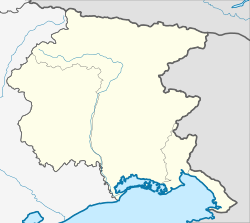
Friuli-Venezia Giulia is one of the 20 regions of Italy and one of five autonomous regions with special statute. The regional capital is Trieste on the Gulf of Trieste, a bay of the Adriatic Sea.
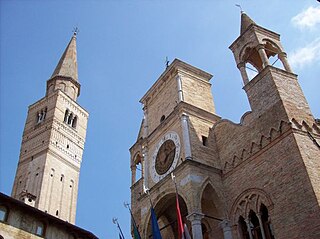
Pordenone is a comune (municipality) of the northeast Italian region of Friuli-Venezia Giulia, the capital of the Regional decentralization entity of Pordenone.

The Province of Udine was a province in the autonomous region Friuli Venezia Giulia of Italy, bordering Austria and Slovenia, with the capital in the city of Udine. Abolished on 30 September 2017, it was reestablished in 2019 as the Regional decentralization entity of Udine, and was reactivated on 1 July 2020. It has a population of 530,849 inhabitants over an area of 4,907.24 square kilometres (1,894.70 sq mi).
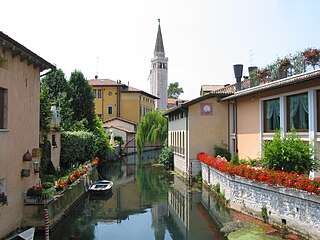
Sacile is a comune (municipality) in the Regional decentralization entity of Pordenone, in the Italian region of Friuli-Venezia Giulia. It is known as the "Garden of the Serenissima" after the many palaces that were constructed along the river Livenza for the nobility of the Most Serene Republic of Venice.

The Tagliamento is a braided river in north-east Italy, flowing from the Alps to the Adriatic Sea at a point between Trieste and Venice.

Tolmezzo is a town and comune (municipality) in the Regional decentralization entity of Udine, part of the autonomous Friuli Venezia Giulia region of north-eastern Italy.
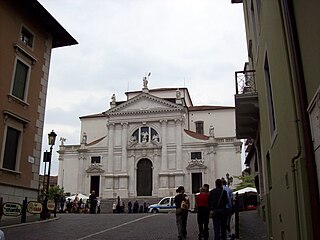
San Daniele del Friuli is a comune (municipality) in the province of Udine, in the Italian region of Friuli-Venezia Giulia, located about 80 kilometres (50 mi) northwest of Trieste and about 20 kilometres (12 mi) northwest of Udine.

Venzone is a comune (municipality) in the Regional decentralization entity of Udine in the Italian region of Friuli Venezia Giulia. It is a member of the I Borghi più belli d'Italia association.
Castelnovo del Friuli is a comune (municipality) in the Regional decentralization entity of Pordenone, in the Italian region of Friuli-Venezia Giulia, located about 90 kilometres (56 mi) northwest of Trieste and about 30 kilometres (19 mi) northeast of Pordenone.

Pinzano al Tagliamento is a comune (municipality) in the Regional decentralization entity of Pordenone, in the Italian region of Friuli-Venezia Giulia, located about 90 kilometres (56 mi) northwest of Trieste and about 35 kilometres (22 mi) northeast of Pordenone.

San Vito al Tagliamento is a comune (municipality) in the Regional decentralization entity of Pordenone, in the Italian region of Friuli-Venezia Giulia, located about 80 kilometres (50 mi) northwest of Trieste and about 20 kilometres (12 mi) southeast of Pordenone.

Sequals is a comune (municipality) in the Regional decentralization entity of Pordenone, in the Italian region of Friuli-Venezia Giulia, located about 100 kilometres (62 mi) northwest of Trieste and about 25 kilometres (16 mi) northeast of Pordenone.

Sesto al Reghena is a comune (municipality) in the Regional decentralization entity of Pordenone, in the Italian region of Friuli-Venezia Giulia, located in the lower Friulian-Venetian plain about 80 kilometres (50 mi) northwest of Trieste and about 20 kilometres (12 mi) southeast of Pordenone.
Travesio is a comune (municipality) in the Regional decentralization entity of Pordenone, in the Italian region of Friuli-Venezia Giulia, located about 100 kilometres (62 mi) northwest of Trieste and about 30 kilometres (19 mi) northeast of Pordenone. As of 31 December 2004, it had a population of 1,816 and an area of 28.8 square kilometres (11.1 sq mi).
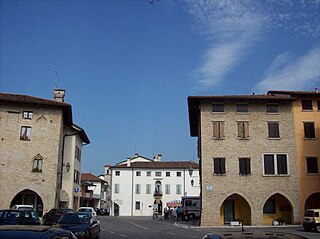
Valvasone Arzene is a comune (municipality) in the Regional decentralization entity of Pordenone in the Italian region of Friuli Venezia Giulia, located about 80 kilometres (50 mi) northwest of Trieste and about 15 kilometres (9 mi) east of Pordenone. It was formed on 1 January 2015 after the merger of the previous comuni of Valvasone and Arzene.
The Castle of Zoppola is an 11th-century castle in Zoppola, in the Province of Pordenone in the Italian region of Friuli Venezia Giulia.
Banca Mediocredito del Friuli Venezia Giulia S.p.A. is an Italian commercial bank based in Udine, Friuli – Venezia Giulia region.

Villa Cigolotti is an historical facility located in the Municipality of Vivaro, Province of Pordenone, in the Friuli Venezia Giulia Region on the north eastern part of Italy.
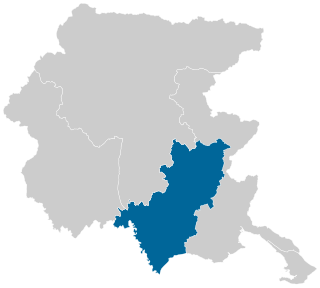
The Udine electoral district was an uninominal district in Italy for the Chamber of Deputies.




